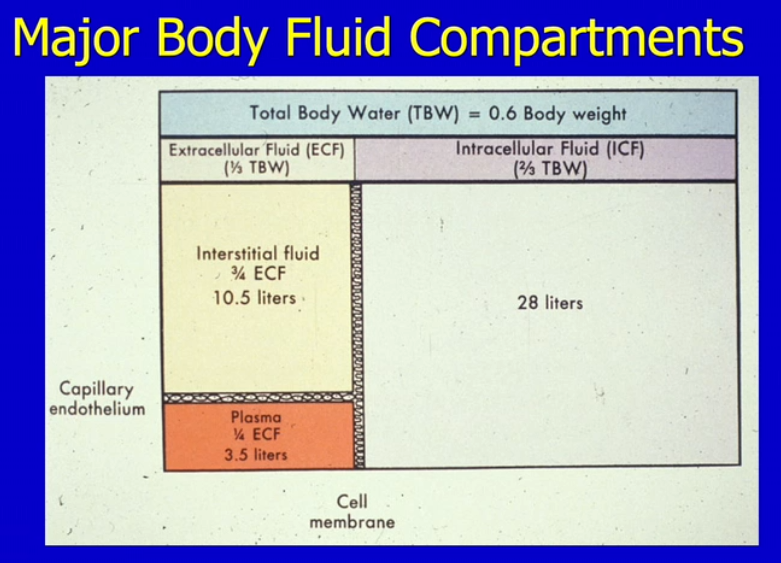Body Fluid Compartments
Compartments and homeostasis
Each cell is surrounded by a fluid, and that fluid is referred to as milieu interieur.
A typical capillary bed will bring nutrients into cell, use them, and expel them into the system. Therefore, the body spends a lot of time and energy regulating this exchange system.
Homeostasis is the process by which the body maintains constancy in internal function in the face of changes in the external environment
Physiological systems
- The circulatory system
- The respiratory system
- Gastrointestinal system
- Renal/urinary system
- Musculoskeletal system
- Nervous system
- Endocrine system
Fluid volume
The percentage of the body that is fluid varies by stage of life. It starts out high (80%) as infants and declines into adulthood (60%). The normal amount is 60%.
Obese adults have less fluid (40-50%) and the opposite is true for emaciated adults (70-75%), which is dependent on adipose tissue.
The is more fluid inside cells (25L) than out (15L). There is also more plasma volume (3L) than red blood cell volume (2L).

2/3 of fluid is is inside cells. The separation between these two is the cell membrane.
The interstitial compartment is what one would consider the milieu interieur which is separated from the plasma by the capillary endothelium.
Plasma
- Anion: Cl-
- Cation: Na+
- Other components: HCO3-, Proteins (-)
Intercellular fluid
- Anion: Cl-
- Cation: Na+
- Other components: HCO3-
Intracellular fluid
- Anion: Misc. phosphates (-), Proteins (-)
- Cation: K+
- Other components: HCO3-
Permeation
The lipid bilayer (cell membrane), allows non-polar substances to diffuse across but prevents electrolytes from readily crossing
The capillary wall is more porous. Therefore, plasma and intercellular fluid have similar makeups as they can exchange materials. The exception to this is proteins.
Solute Distribution
Na+ (more OUTSIDE)
- Inside: 10 mEq/L
- Outside: 140 mEq/L
K+ (more INSIDE)
- Inside: 150 mEq/L
- Outside: 4 mEq/L
Measurement of Compartments
Indicator dilution technique
Trying to measure a compartment of unknown size.
Mole: Molecular weight of a substance in grams
1 mol of Na = 23g
1 millimole of Na = 23 milligrams
Electrolytes dissociate when dissolved in fluids (1 mmol → 1 mEq)
Non-electrolytes do not dissociate when dissolved in fluids (1 mmol → # ions mEq)
Measurement of Plasma
Criteria: Indicator is restricted to injected compartment
Possible indicators:
- Evans blue dye (plasma protein binding)
- Radioiodine labeled (I) serum albumin (RISA). Will restrict itself to plasma compartment
PROBLEM
Medical student is infused with 6mg of Evans Blue dye. Plasma conc. after eq. was 2 mg/L. Find the plasma volume.
SOLUTION
6mg = quantity (Q)
2 mg/L = conc. (C)
V = Q / C = 6/2 = 3
Measurement of ECF
Criteria: Restricted to ECF. Can be injected into/obtained from plasma which is part of ECF
Possible indicators:
- Radioisotopes (sulfate, chlorine, etc..)
- Nonmetabolizable saccharides (inulin, mannitol, raffinose, etc..)
- Radioactive iothalamate (I-iothalamate)
PROBLEM
The ECF volume was measured to be 14 liters. What is the body weight (BW)?
SOLUTION
ECF = 1/3 BW (33%)
BW = 3 x ECF = 3 x 14 = 42L
Fluid is 60% of TBW
42 / 0.6 = 70kg
PROBLEM
An individual is injected with 750,000 cpm of tritium-labeled water. The plasma activity conc. was found to be 25 cpm/ml. Find the total body water (TBW).
SOLUTION
= 30,000 ml = 30L
This is TBW as labelled water will diffuse everywhere.
Measurement of other fluid compartments
Problem: Tracers are not restricted to a particular compartment
Approach: Use 2 tracers, one per compartment
Example: If can't measure the interstitial compartment directly, but can measure the intercellular compartment and subtract out the other compartment
PROBLEM
Individual is injected with two indicators (mannitol and deuterium). Mannitol volume was found to be 15L and deuterium volume was found to be 45L. Which body fluid compartments can be estimated by these data?
SOLUTION
Deuterium = TBW = 45L
Mannitol = ECF = 15L
Intercellular fluid = 45L - 15L = 30L
Measuring blood volume
Approach 1:
- Measure plasma volume
- Find hematocrit (% of blood that is cells)
- Divide plasma volume by % of blood that is plasma (conc. of 1 - hematocrit)
Approach 2:
- Tag red blood cells with radio-chromium and inject
- Find volume of distribution (intravascular component)
PROBLEM
Radio-iodinated albumin distribution was found to be 3000ml and the hematocrit was 40%. Calculate blood volume.
SOLUTION
Hematocrit = 40%
Plasma vol. = 3L
% of blood that is plasma = [1 - 0.4] = 0.6
BV = 3L / 0.6
BV = 5L